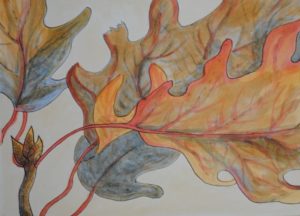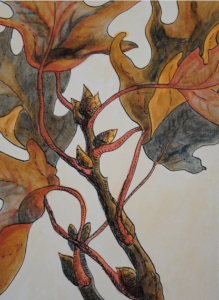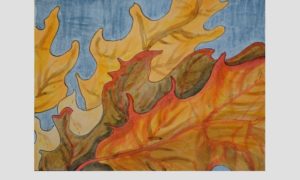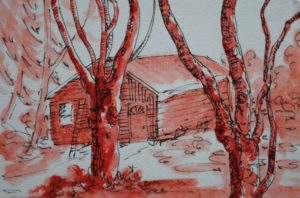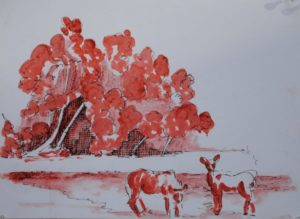Dragon’s Blood
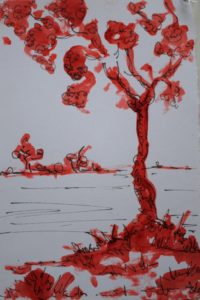
What a name! There’s a long history behind that name and I’ll give a bit of it later, but from a natural-dyes point of view it is one of the best reds I’ve found. For the purist who only wants to use local (north American or European) plants, obviously this won’t do. For the rest of us, this pigment (actually it’s a resin) is quite easily available. Kremer Pigments, among other pigment suppliers, sells it. Dragon’s Blood resin, usually sold as a powder, produces a fabulous ruby red and deep pink, and it isn’t fugitive.
As a pigment, Dragon’s Blood has quite a pedigree. It mixes well with various varnishes and is found in the varnish coating of Stradivarius violins and old Chinese furniture. The resin also has various other uses, such as in incense, photo engraving, and body oil. In medieval times it was used in various medicines for blood coagulants, antidiarrheal agents, lowering fevers, and curing skin disorders.
That Dragon’s Blood works well with various varnishes is a bit of a give away from an artist point of view, as this resin doesn’t work well with a lot of standard painting media. I did some tests over the winter to see what it mixes best with and how it paints, etc,. and discovered some interesting things discussed below.
At the same time, Dragon’s Blood works well with other natural dyes. It creates an orange when applied over (or under) yellows and enhances browns (walnut) and even affects the rather overwhelming blue of indigo. The three paintings below–ink drawings of oak leaves that fell from a neighbor’s tree–show how well this color can fit into multicolored works.
From my experiments mixing Dragon’s Blood with different painting media, I found that the two best ways of getting it onto paper and keeping its original color are:
- mixing the pigment with pharmacy alcohol, or
- adding it to a mix of stand oil & pharmacy alcohol.
The latter produces a deep rich red, but it doesn’t spread well on highly absorbent papers like watercolor paper. Bristol Board and Bristol Vellum work better. The three pure-Dragon’s Blood-only color & ink sketches shown in this commentary are all on Bristol Board.
The alcohol-only based paint makes a strong pink wash that can be built up in terms of saturation through repeated applications once the previous one has dried (which doesn’t take long). The oak leaves above are a good example.
Two sketches using Dragon’s Blood resin mixed with different painting media
Where Dragon’s Blood comes from
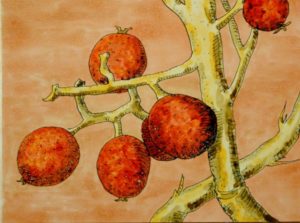
This deep red resin comes primarily from two types of plants, which are both in the grass (monocot) family. In ancient times–certainly by the time the Ancient Greeks and Romans were writing–the resin came exclusively from subtropical trees native to the Azores, off the coast of Africa, and Socotra in the Indian Ocean off Yemen. The trees look like something weird out of Lord of the Rings rather than regular trees, being huge, mushroom shaped constructs, and are called, no surprise, Dragon Trees. We are all familiar with some of the plants in this genus, which all come from these islands, as they are now commonly grown as houseplants–Dracaena spp. The ancient Greeks also called the red resin the trees produce Dragon’s Blood, and the name has stuck for over two thousand years.
Today, the Dracaena draco trees are protected species and are rare. Over the past century or so, most commercial Dragon’s Blood resin comes from tropical vines found in Indonesia, which we know best as Rattan, or Daemonorops spp, in particular D. draco,(the similarity of the two Dragon’s Blood-producing species names is not a coincidence). It is grown commercially on several islands, in particular Sumatra, which is the source of Kremer Pigments’ cache. The Daemonorops resin is secreted on the surface of unripe fruit, that look a bit like round strawberries. See my sketch to the right.
Finding the right medium
As mentioned earlier, Dragon’s Blood resin doesn’t work well with a lot of standard painting media. I did some tests over the winter to see what it mixes best with and how it paints, etc. There were a lot of losers in terms of the mixes used, and the winners perhaps should not come as a surprise.
Winners: pharmacy alcohol, stand oil/alcohol mix, and Canada Balsam (both alone and mixed with alcohol).
Losers: It doesn’t mix well with water, regular linseed oil or any of the synthetic oils and media (liqin, mixed “painting mediums”, etc). With some of these you don’t get any color at all! with others, especially the petroleum based items, the red turns brown within months of it being applied.
I drew the trumpet vine below back in August last year, before I started seriously experimenting with media with which to mix Dragon’s Blood pigment. I used a commercial painting medium consisting of stand oil/white spirits/oil of spike lavender, and the red had turned brown by October. It was this event that made me realize I had to work at finding the right medium for using Dragon’s Blood in pen&ink drawings, and it turned out to be a six month long exploration!
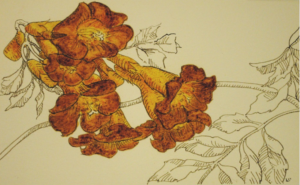
Mixing the resin with alcohol produces a deep pink, which is fast. However, if you keep the batch of DB/alcohol and use it again several weeks later, the color degrades a bit. So if you want to keep the pink at its peak color, it is best to mix a fresh batch of DB/alcohol each time you use it.
Nevertheless, I’ve found that the slightly degraded color is still useful. Dragon’s Blood mixed with alcohol produces a slightly textured wash that creates a good background color. The sketch I made of the Daemonorops fruit uses a month-old DB/alcohol mix for the background wash.
The richest, deepest color is from the DB/stand oil/alcohol mix, and (so far) it doesn’t appear to degrade once painted. Canada Balsam maintains the rich Dragon’s Blood red as well, but the uses for this material in any painting is limited due to the viscosity of the medium. When Dragon’s Blood is mixed with Canada Balsam and alcohol, makes a wash similar to DB/alcohol, except it is grainy.
So, this is a color well worth using, but it needs special handling. Also, the resin pigment is expensive, but considering how little is used in any botanical or pen&ink drawing, 100mg of this pigment could probably last a decade or more!
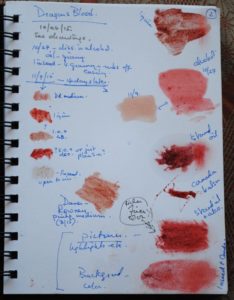
Here is a page from my notebook where I make tests of various natural dyes and media. This is part of my Dragon’s Blood medium testing section.
Notes
For more information on this subject, the following three sources are good.
Plant Resins: Chemistry, Evolution, Ecology and Ethnobotany [2003], by Jean H. Langenheim. [Timber Press, Inc] Probably the definitive book on the subject, as Langenheim is an expert on plant resins. There are many other art-related products described in this book (did you know Copal was a resin?), which makes it well worth reading, and keeping as a reference book.
If you are interested in woodworking and carpentry, Marianne Webb’s site (she’s a decorative arts conservator), is worth visiting: http://mariannewebb.com/archives/383
Wikipedia’s description of Dragon’s Blood is excellent, with a lot of geo/historical information on the “original” Dragon’s Blood source.
Also, I thank fine artist Marguerite de Soleil (link) for starting me on the road to discovering natural dyes as painting/art ingredients. Without her enthusiasm, while she was teaching at the Woodstock School of Art, this interest might never have been kindled.
